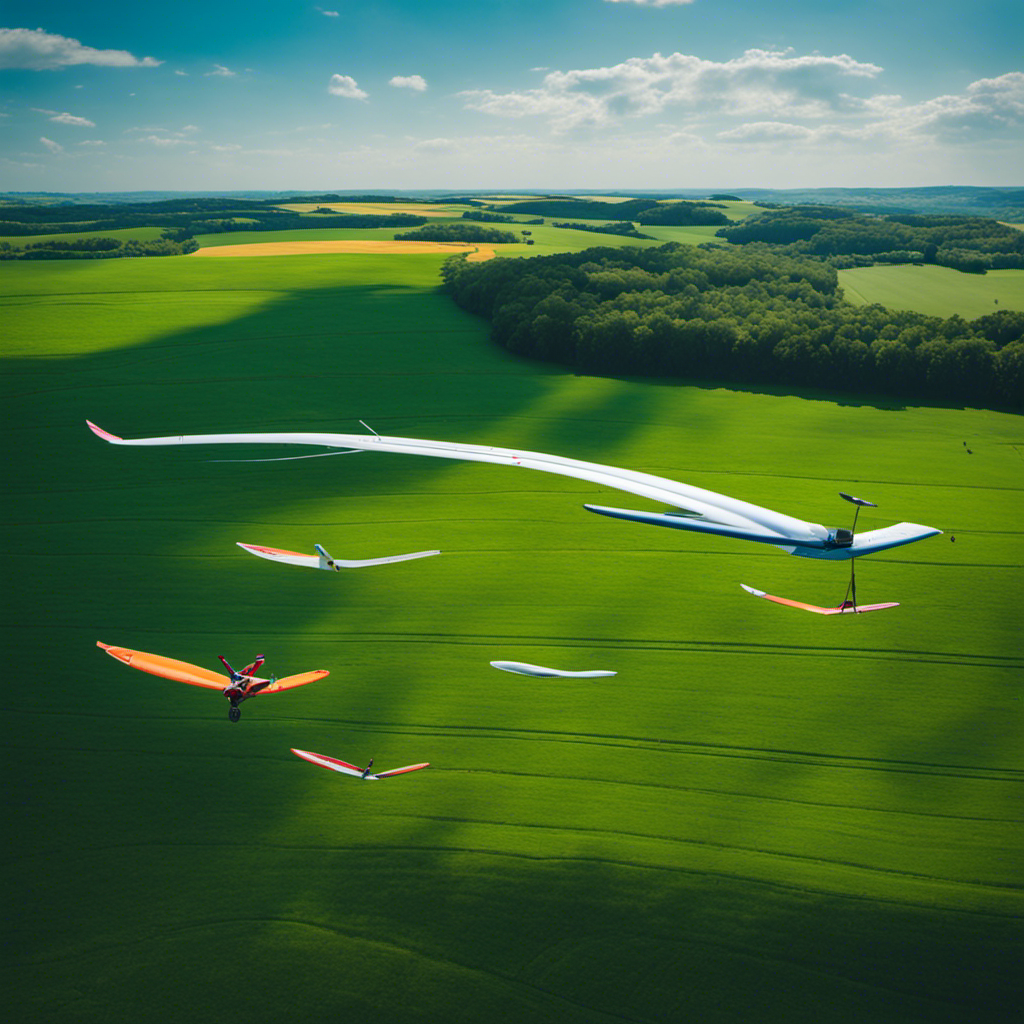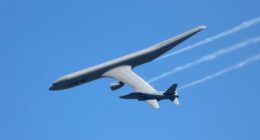As they say, ‘The sky’s the limit!’ If you’ve ever dreamed of soaring through the air like a bird, then gliding competitions might be just the adventure you’re looking for.
In this beginner’s guide, I’ll take you through everything you need to know to get started in the thrilling world of gliding competitions. From choosing the right glider to mastering essential techniques, I’ll share tips and advice to help you navigate the skies with confidence.
Let’s dive in and discover the exhilaration of gliding competitions together!
Key Takeaways
- Choosing the right glider and regularly inspecting and servicing it is crucial for optimal performance in gliding competitions.
- Mental preparation techniques such as deep breathing exercises, visualization, and positive affirmations can help build confidence and improve performance.
- Physical conditioning exercises, including warm-ups and stretching, are important for building strength, endurance, and flexibility necessary for gliding competitions.
- Understanding the scoring system, weather conditions, and mastering gliding techniques such as thermaling, cross-country flights, and energy management are key to success in gliding competitions.
Choosing the Right Glider
When choosing the right glider for competition, you’ll need to consider factors such as wing loading and performance specifications. Glider maintenance and handling techniques are also crucial aspects to consider.
Glider maintenance requires regular inspections and servicing to ensure optimal condition. This includes checking the wings, control surfaces, and landing gear. Following the manufacturer’s recommended maintenance schedule and guidelines is important for safety and performance.
In terms of handling techniques, mastering takeoff, landing, and maneuvering is essential. Proper handling involves maintaining a smooth and stable flight, making precise turns, and controlling speed and altitude. Understanding the glider’s performance capabilities and limitations is also important.
Understanding the Scoring System
When it comes to understanding the scoring system in gliding competitions, there are two key points that need to be explained: the scoring criteria and the impact of weather conditions.
The scoring criteria determine how points are awarded based on factors such as distance flown, speed, and precision of landings.
Weather conditions, on the other hand, can greatly affect a pilot’s performance and ultimately their score, as wind strength and direction can impact glide paths and thermals.
Scoring Criteria Explained
The scoring criteria in gliding competitions are explained in detail to ensure fair evaluation. Each competition has its own set of rules and scoring techniques, but the basic principles remain the same.
Here are some key points to understand about the scoring criteria:
-
Flight Distance: The distance covered by the glider is a crucial factor in determining the score. Longer distances generally result in higher scores.
-
Speed: The time taken to complete the flight is also considered. Faster speeds lead to higher scores.
-
Precision: The ability to accurately fly through designated checkpoints or targets is another aspect that is evaluated. Pilots who demonstrate precise flying skills earn more points.
-
Safety: Safety is of utmost importance in gliding competitions. Points may be deducted for any violations or unsafe maneuvers.
Glider selection is also an important factor in scoring. The performance capabilities and handling characteristics of the glider play a significant role in determining the overall score. It is essential for competitors to choose a glider that suits their flying style and skill level to maximize their chances of success.
Impact of Weather Conditions
Weather conditions can greatly affect the performance and scoring of gliders in competitions. As a glider pilot, I understand the importance of weather forecasting and its impact on flight performance. Accurate weather predictions allow us to make informed decisions about when and where to fly.
Unfavorable weather conditions such as strong winds, turbulence, or thunderstorms can make flying dangerous and affect the overall performance of the glider. On the other hand, favorable weather conditions like thermals and ridge lift can enhance the glider’s performance and allow for longer flights.
Understanding weather patterns and being able to adapt to changing conditions is crucial in a gliding competition. It allows pilots to strategize and maximize their chances of success. Therefore, keeping a close eye on weather forecasts is an essential part of preparing for a gliding competition.
Essential Equipment for Competitions
Pilots must have the necessary equipment for competitions, such as a parachute and a radio. These items are essential for ensuring safety and effective communication during gliding competitions.
-
Parachute requirements: A reliable parachute is a must-have for every pilot participating in gliding competitions. It serves as a crucial safety measure in case of emergencies or unexpected situations. Pilots need to ensure that their parachute is in good condition, regularly inspected, and meets the necessary safety standards.
-
Communication devices: Communication is vital for pilots during competitions. They need to stay in constant contact with the competition organizers, air traffic control, and other pilots. A radio is the primary communication device used in gliding competitions. Pilots should have a radio with a range suitable for the competition area and ensure that it is fully functional before the event.
-
GPS system: A Global Positioning System (GPS) is another valuable tool for gliding competitions. It helps pilots track their position accurately and navigate through the competition area. A GPS system provides crucial information about altitude, speed, and distance, enhancing the pilot’s performance and decision-making abilities.
-
Emergency locator beacon: In case of an emergency landing or a pilot getting lost, an emergency locator beacon can be a lifesaver. This device transmits a distress signal, allowing rescue teams to locate the pilot quickly. It is essential to have a functioning emergency locator beacon that meets the required standards for competitions.
Having the right equipment ensures the safety and success of pilots participating in gliding competitions. Pilots should always check and maintain their equipment to ensure it is in proper working condition before each competition.
Preparing for Flight Competitions
When it comes to preparing for flight competitions, there are three key points to consider: mental preparation techniques, physical conditioning exercises, and equipment checklist essentials.
Mental preparation techniques involve developing focus, resilience, and visualization skills to stay calm and focused during the competition.
Physical conditioning exercises are crucial for building strength, endurance, and flexibility to handle the physical demands of flying.
Mental Preparation Techniques
One of the most effective ways to mentally prepare for a gliding competition is by practicing deep breathing exercises. Deep breathing helps to calm the mind and reduce anxiety, allowing you to focus on the task at hand.
In addition to deep breathing, visualization techniques can also be beneficial. By visualizing yourself successfully completing each maneuver, you can build confidence and improve your performance.
Another helpful technique is the use of positive affirmations. By repeating positive statements to yourself, such as ‘I am confident and capable,’ you can boost your self-esteem and belief in your abilities.
Lastly, it is important to remember to stay present and focused during the competition, avoiding distractions and maintaining a clear mindset.
Transitioning into the subsequent section about physical conditioning exercises, it is important to not only prepare mentally but also physically for a gliding competition.
Physical Conditioning Exercises
To improve your performance in a gliding competition, you should incorporate physical conditioning exercises into your training routine.
Physical conditioning is essential for gliders as it helps to build strength, endurance, and flexibility, which are crucial for maneuvering the glider effectively.
Before starting any exercise, it’s important to warm up your muscles to prevent injuries. Simple warm-up routines like jogging or jumping jacks can get your blood flowing and loosen up your muscles.
Additionally, stretching techniques are vital to increase flexibility and prevent muscle strains. Focus on stretching your arms, legs, and back to ensure your body is ready for the demands of gliding.
Incorporating these physical conditioning exercises into your training routine will greatly enhance your performance in gliding competitions.
Equipment Checklist Essentials
Check if you have all the essentials on your equipment checklist before you start preparing for your gliding adventure. It is crucial to have the necessary items to ensure a safe and successful flight. Here are the key items to include in your checklist:
-
Parachute: A parachute is an essential safety device in case of emergencies during flight. Make sure it’s properly packed and in good condition.
-
Radio: A reliable two-way radio is crucial for communication with the ground and other pilots during the flight.
-
Flight instruments: These include an altimeter, airspeed indicator, variometer, and compass. They provide essential information for navigating and managing in-flight emergencies.
-
Safety harness: A secure and comfortable safety harness is necessary to keep you securely fastened in the glider during takeoff and landing.
Mastering Gliding Techniques
When you’re gliding, it’s important to master different techniques to enhance your performance. By practicing these gliding techniques and training exercises, you can improve your skills and increase your chances of success in competitions. Here are some key techniques to focus on:
| Technique | Description |
|---|---|
| Thermaling | Finding and using thermals, which are columns of rising air, to gain altitude and stay aloft. |
| Cross-Country Flying | Planning and executing long-distance flights, using wind patterns and landmarks for navigation. |
| Speed-to-Fly | Calculating the optimal speed to maintain during a flight, taking into account wind and glide ratio. |
| Energy Management | Efficiently using altitude, speed, and potential energy to maintain momentum and avoid sinking. |
| Landing Approach | Executing a smooth and controlled approach to the landing zone, considering wind and terrain. |
| Aerobatics | Performing precision maneuvers and figures, showcasing your skill and control in the air. |
To master these techniques, it’s important to practice regularly and seek guidance from experienced gliders or instructors. Training exercises such as simulated flights, navigation challenges, and precision landings can help refine your skills. Additionally, studying weather patterns and understanding the dynamics of the atmosphere will give you an advantage in utilizing thermals and optimizing your flight path. Remember, the more you practice and learn, the better you will become at gliding and the more successful you will be in competitions.
Strategies for Successful Navigation
As I navigate through long-distance flights, wind patterns and landmarks serve as valuable tools for successful navigation. When planning my route, I consider various navigation techniques to ensure a smooth and efficient journey. Here are some strategies I employ:
-
Wind Patterns: Understanding wind patterns is crucial for glider pilots. By studying meteorological reports and observing cloud formations, I can identify areas of lift and sink, allowing me to optimize my route and conserve energy.
-
Landmarks: Landmarks provide visual reference points that help me stay on track. I make note of prominent features such as mountains, rivers, and towns, using them as guideposts to ensure I’m following the intended path.
-
GPS Systems: While traditional navigation methods are essential, modern technology also plays a role. I utilize GPS systems to track my position, monitor groundspeed, and navigate accurately, especially in unfamiliar areas.
-
Flight Planning Software: Flight planning software helps me analyze weather conditions, calculate optimal routes, and estimate flight times. These tools provide valuable insights and assist in making informed decisions during the flight.
Safety Guidelines and Regulations
To ensure safety during long-distance flights, it’s important to adhere to established guidelines and regulations. Gliding competitions can be thrilling, but safety should always be the top priority.
Before taking off, it’s crucial to take the necessary safety precautions. This includes conducting a thorough pre-flight inspection of the glider, ensuring all equipment is in proper working order, and wearing appropriate safety gear such as a helmet and a parachute.
During the flight, it’s essential to be aware of emergency procedures. Familiarize yourself with the glider’s emergency checklist and know how to handle any unexpected situations. This includes understanding how to perform emergency landings and knowing the locations of emergency landing sites along the planned route. It’s also important to stay vigilant and constantly assess the weather conditions to avoid flying in hazardous weather.
In addition to personal safety measures, it’s crucial to follow the established regulations and guidelines set by the gliding association or organization. These regulations are in place to ensure the safety of all participants and to maintain a fair and competitive environment. Violating these regulations can not only jeopardize your safety but also result in disqualification from the competition.
Participating in Gliding Competitions: Tips and Advice
It’s important to prepare yourself for gliding competitions by familiarizing yourself with the rules and regulations in order to have a successful experience. Participating in gliding competitions can be a thrilling and rewarding experience, but it requires careful planning and preparation.
Here are some tips and advice for those considering entering a gliding competition:
-
Finding sponsors: Gliding competitions can be expensive, so it’s important to secure sponsors to help cover the costs. Reach out to local businesses or organizations that may be interested in supporting your passion for gliding. Offer to promote their brand or services during the competition in exchange for financial assistance.
-
Managing nerves: Competing in gliding competitions can be nerve-wracking, especially for beginners. To manage your nerves, try practicing relaxation techniques such as deep breathing or visualization exercises. Additionally, make sure to get enough rest and eat a healthy meal before the competition to help keep your nerves at bay.
-
Stay focused: During the competition, it’s crucial to stay focused and maintain a clear mind. Remember to follow the rules and regulations, and stay attentive to the instructions given by the competition organizers. Keep a positive mindset and trust in your training and skills.
-
Learn from the experience: Whether you win or not, participating in gliding competitions is a valuable learning experience. Take the time to reflect on your performance, identify areas for improvement, and use the feedback from judges and fellow competitors to grow and develop as a glider.
Frequently Asked Questions
Are Gliding Competitions Open to Everyone, or Do You Need a Specific Level of Experience to Participate?
Gliding competitions are open to everyone, regardless of their level of experience. There is no specific requirement to participate in these competitions. Whether you are a beginner or an experienced glider pilot, you can enter and compete against others.
This inclusivity allows for a diverse range of participants, creating an exciting and challenging environment. So, if you have always wanted to try gliding competitively, don’t hesitate to join a competition and test your skills against other glider pilots.
What Are the Common Penalties or Disqualifications That Can Occur During a Gliding Competition?
Common penalties and disqualifications in gliding competitions can be quite daunting for beginners. Navigating without landmarks is a major challenge. Accidentally straying off course or failing to follow the designated route can result in penalties or even disqualification.
These penalties are meant to ensure fair competition and maintain safety standards. It is crucial for participants to familiarize themselves with the rules and regulations to avoid any potential penalties or disqualifications during a gliding competition.
How Do Gliders Navigate During Competitions, Especially When There Are No Visible Landmarks?
When there are no visible landmarks, gliders rely on navigational techniques and weather conditions to determine their location during competitions.
Pilots use instruments such as GPS devices and variometers to navigate accurately.
They also analyze weather patterns and wind directions to plan their routes.
It is crucial to consider the weather conditions, as they can greatly affect the glider’s performance and trajectory.
With proper navigation and weather analysis, gliders can successfully compete and complete their flights.
Are There Any Restrictions or Regulations Regarding the Use of Technology, Such as GPS Devices, During Gliding Competitions?
During gliding competitions, the use of technology, such as GPS devices, is regulated. There are restrictions in place to ensure fair competition and maintain the spirit of gliding.
While GPS devices can be used for navigation, they are often limited to basic functions and are not allowed to provide real-time data or assistance. This ensures that pilots rely on their skills and judgment rather than relying heavily on technology.
The regulations aim to maintain the challenge and excitement of gliding competitions.
Can Participants Bring Their Own Gliders to a Competition, or Are They Provided by the Event Organizers?
Participants are responsible for bringing their own gliders to gliding competitions. The event organizers do not provide gliders for the participants.
This allows participants to use their own preferred gliders that they are comfortable with and have trained on. However, there may be certain regulations and restrictions regarding the specifications and safety requirements of the gliders that participants can bring to the competition.
It is important for participants to adhere to these guidelines to ensure a fair and safe competition.
Conclusion
In conclusion, gliding competitions are an exhilarating and challenging experience for any beginner glider pilot. From choosing the right glider to understanding the scoring system and mastering gliding techniques, there is much to learn and explore in this sport.
By following essential safety guidelines and regulations, as well as preparing adequately, one can participate in these competitions with confidence. Remember, success in gliding competitions requires dedication, practice, and a strong understanding of navigation strategies.
So, spread your wings and soar to new heights in the thrilling world of gliding competitions!




